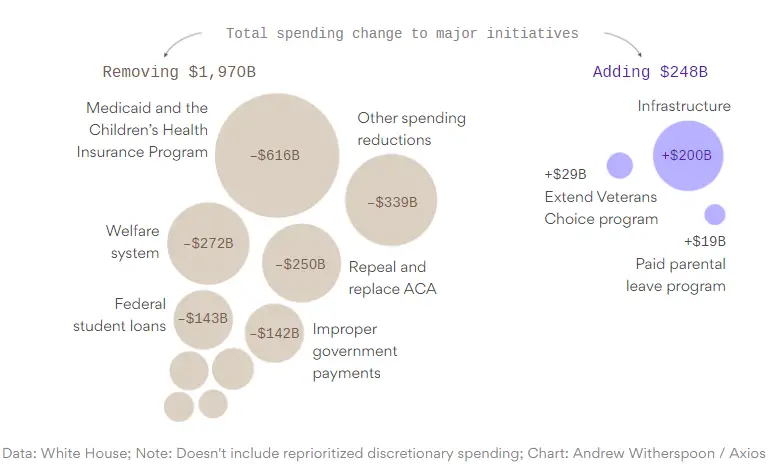The White House has released a budget plan today which aims to cut trillions (yes, trillions) of dollars over 10 years and touches many significant programs such as Medicaid and food stamps spending. The White House refers to it as a “taxpayer first” plan with an eye toward reducing government spending over the long haul. The release was met with hostility from Senate Democratic Minority Leader Chuck Schumer, who attacked the cuts as “America turned upside down.”
Axios news gives us a rundown of the major points as outlined by White House Budget Director, Mick Mulvaney:
Office of Management and Budget director Mick Mulvaney briefed White House reporters today on President Trump’s 2018 budget proposal, to be released tomorrow morning. Here’s what you need to know:
-$3.6 trillion in total spending reductions over 10 years
-Includes $1.7 trillion in savings from “mandatory” spending
-Biggest savings: More than $800 billion from health care
-Balances the budget in 10 years
Axios also provided a graphic if you prefer the details in chart form:
Some more background from the Washington Post:
President Trump on Tuesday will propose cutting federal spending by $3.6 trillion over 10 years, a historic budget contraction that would severely ratchet back spending across dozens of programs and could completely reshape government assistance to the poor.
The White House’s $4.094 trillion budget request for fiscal 2018 calls for cuts that hit Medicaid, food assistance and other anti-poverty programs. It would cut funding for the Children’s Health Insurance Program (CHIP), which provides benefits to the poor, by roughly 20 percent next year.
All told, the budget would reduce spending on safety-net programs by more than $1 trillion over 10 years.
Details of the budget circulating in Washington on Monday drew outrage from Democrats and a mix of anxiety and praise from Republicans, illustrating the political minefield that policymakers face as they debate whether to turn the proposals into law.
Mick Mulvaney, director of the Office of Management and Budget, said the spending plan, titled “A New Foundation for American Greatness,” is focused on protecting taxpayer money and cutting spending on programs that are ineffective or encourage people not to work.
This almost feels more like an opening bid on the part of the White House to get the discussion started. They’re calling for significant cuts which the Democrats will never agree to. As a result, the White House can “compromise” to smaller cuts and still have something of a win – at least that’s the theory.
Some of the numbers here rely on increased economic activity resulting from Trump’s tax plan to spur economic growth. There are a lot of moving parts, and so far, his domestic agenda has been stalled and stifled at every turn.
Senator Elizabeth Warren (D-MA) wasted no time in ripping the budget as an assault on children and families, which basically encapsulates the entire Democratic response to all of Trump’s economic-related proposals:
.@realDonaldTrump’s @usedgov budget is an all-out assault on America’s kids, teachers, college students & student loan borrowers. pic.twitter.com/F1UoJTPdrd
— Elizabeth Warren (@SenWarren) May 22, 2017
As Hot Air points out, however, this budget might be a meaningless document, since budgets originating from the White House usually don’t go very far:
Bear in mind that White House budget proposals are almost entirely political documents. Congress creates budgets, not presidents, although presidents have to sign them. These budgets get used to set the tone for the upcoming negotiations on Capitol Hill, and it seems clear that Trump and Mulvaney want to shift the Overton windows on discussions over safety-net programs. Trump’s brash enough to do that and make it work, or so he and Mulvaney believe. Eventually, they will need to show even more leadership and courage, and shift the Overton windows on Medicare and Social Security too — and make it plain that it’s going to cost Democrats in every other budget line item until they accept the need to reform entitlements. Perhaps this is step one in that process.
Back during President Obama’s term, his budgets were often brought to the floor by the Republican majority just to make a show of voting them down almost unanimously with Democratic support. See this story from March 24, 2015:
President Obama’s budget suffered its latest ignominious defeat when the Senate rejected it on a 98-1 vote Tuesday evening, capping off the first votes of the budget season.
…
Rejecting presidential budgets has become standard in recent years. The Senate defeated Mr. Obama’s fiscal year 2011 plan by a 97-0 vote and his 2012 plan by a 99-0 vote.
President Trump’s budget proposal might not make it much further depending on how strongly Republicans wish to accept or reject his ideas and formulate them into workable legislation.
Donate Now to Support Election Central
- Help defend independent journalism
- Directly support this website and our efforts

